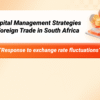
If you’re an e-commerce seller in South Africa, you might be facing this dilemma: your products offer excellent value, but your conversion rate remains low. The problem might lie with your payment methods. South African consumers’ payment habits differ significantly from those in China: some prefer to see the product before paying, others exclusively use local bank e-wallets, and still others find installment payments more cost-effective. According to a 2024 survey by the E-Commerce Association of South Africa (ECSA), 63% of consumers abandon their orders because their preferred payment method isn’t supported. Today, we’ll analyze the four payment methods preferred by local consumers and the corresponding merchant adaptation strategies to help you improve conversion rates.
The first method: EFT (instant transfer), the preferred method for local businesses and high-volume customers. EFT (electronic funds transfer) is a core payment method in the South African banking system, and nearly all local consumers have EFT accounts (such as Capitec and FNB online banking). Its advantages include instant payment and no fees, making it particularly suitable for products with a unit price of over R5,000 (such as appliances, furniture, and building materials). In practice, it’s important to note that e-commerce platforms must provide “EFT transfer instructions,” including the merchant’s bank name, account number, and branch code. Ideally, they should also generate a “unique transfer note” (e.g., “Customer ID + Order Number”) to facilitate reconciliation. For example, South Africa Easybuy, a Chinese-owned home appliance e-commerce platform in Cape Town, automatically generates EFT transfer information on the order confirmation page. After the customer transfers, they upload the transfer receipt. The system confirms the payment and arranges shipment within 10 minutes. This approach has increased their conversion rate for high-value orders by 40%.
The second option: offline payment via POS. Cash on delivery (COD) is essential. Many South African consumers, especially those over 35, still rely on “see the goods before paying.” Therefore, cash on delivery (COD) remains a crucial option. In this scenario, delivery personnel carry mobile POS terminals, and customers pay directly by credit card or NFC after inspection. When choosing a POS machine, consider two key points: first, support for local South African cards, such as Capitec debit cards and Nedbank credit cards, as well as international cards such as Visa and MasterCard (for international tourists). Second, offline payment functionality. Because signal quality is poor in some suburban areas of South Africa, offline payment functionality allows transactions to be stored and synchronized when signal is restored, preventing missed orders. Xiansuda, a Chinese-owned fresh food e-commerce company in Johannesburg, uses a Mustang mobile POS machine for cash on delivery. The POS machine can also be linked to its order system, automatically updating order status after payment, eliminating the need for delivery drivers to manually record transactions, resulting in a 30% efficiency improvement.
Third, e-wallet payment is primarily used by young consumers and those with lower average order values. South Africa’s e-wallet market is growing rapidly, with SnapScan and Zapper being the most popular. These are most popular among consumers aged 25-35 and are suitable for items with an average order value of 100-2000 rand (e.g., clothing, cosmetics, and daily necessities). The usage process is simple: consumers open the e-wallet app, scan the merchant’s QR code, enter the amount, and payment is completed within a minute. When integrating e-wallets, e-commerce platforms should pay attention to payment callback speed—ideally, order status should be synchronized within 10 seconds after successful payment to avoid customers paying but seeing “unpaid” displayed. For example, South Africa Fashion Brands, a Chinese-owned clothing e-commerce platform in Pretoria, includes SnapScan and Zapper QR codes on both product detail pages and the shopping cart, allowing customers to scan and pay directly without being redirected to other pages. This approach has increased repurchase rates among young customers by 25%.
The fourth option: Lay-by installment payments, which stimulate consumption for those with urgent needs but limited budgets. Lay-By is a unique “save now, buy later” installment model in South Africa, somewhat similar to “zero-interest installment payments”: consumers pay a 20% deposit first, then make multiple payments over 3-6 months. Delivery is only available after the final payment is made. There’s no interest and no credit check required, making it suitable for urgent needs with limited budgets (e.g., students buying computers or families buying furniture). When implementing Lay-By, it’s important to clearly define cancellation policies, such as whether the deposit will be refunded if a customer cancels an order after paying (typically, a 10% handling fee will be deducted). It’s also important to have a “final payment reminder” feature that automatically sends text messages or emails to remind customers when their payments are due, to prevent overdue payments. Jiayiju, a Chinese-owned furniture e-commerce company in Durban, launched a Lay-By service, offering customers the option of paying in three or six installments. This method has led to a 50% increase in furniture orders, particularly after payday (most South Africans receive their salaries at the end of the month), when Lay-By orders surge. Finally, a reminder: The best strategy is to combine multiple payment methods, tailored to different customer segments and product types. For example, on the same e-commerce platform, low-priced items could use e-wallets, high-priced items could use EFT, cash on delivery could use POS, and even Lay-By installment payments could be added to cover all scenarios. Mustang’s e-commerce solution achieves this, managing EFT, POS, e-wallets, and Lay-By payment methods from a single backend. It also automatically generates payment reports, eliminating the need to switch between multiple systems and improving reconciliation efficiency by 60%.



Add comment